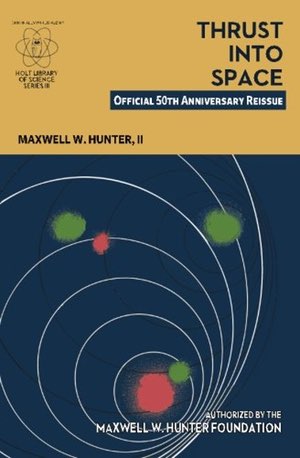Review: Thrust Into Spaceby Jeff Foust
|
| “Propulsion, however, determines the economic feasibility of space operations,” he wrote. |
Hunter was also the author of a book on spaceflight, Thrust Into Space, first published in 1966. His foundation recently reissued the book to mark the 50th anniversary of its publication. Originally written to provide readers with an overview of the prospects and challenges of traveling into space, it now offers a glimpse of what could have been, or might some day still be, in spaceflight.
Hunter wrote the book to explain to readers what it takes to place a payload into Earth orbit or beyond. Starting with the basics of physics and engineering, he works his way out from suborbital “artillery rockets” to launch vehicles that achieve orbit, and then missions to the Moon and elsewhere in the solar system. One chapter near the end even examines interstellar spacecraft.
The focus on all the chapters is on the propulsion aspects of spaceflight: the velocities and trajectories required, and what kinds of propulsion technologies can meet those requirements. Propulsion, in his mind, was the essential issue for any transportation into orbit or beyond. “In the future, propulsion is undoubtedly the key to the magnitude of further space exploration and exploitation,” he writes in the book’s preface. Other technologies are important, he acknowledges, yet secondary. “Propulsion, however, determines the economic feasibility of space operations.”
At the time Hunter published the book, spaceflight was still in its infancy, with the industry growing rapidly and visions of the future expanding even faster. The book features a wide range of nuclear propulsion concepts, which Hunter saw as key to opening the solar system. For example, in a chapter on “solar system spaceships” he discusses a range of nuclear propulsion options, including concepts known as gaseous core fission rockets that he believed could provide extremely low cost access to the solar system. “This is the lure of the gaseous fission powered spaceship—transportation costs throughout the solar system which are not much greater than terrestrial transportation costs,” he writes, a statement italicized for emphasis in that chapter.
Fifty years later, that promise of cheap nuclear-powered spaceflight seems as distant as ever. The quest for reusability and low-cost access to space to some lesser degree remains, though. Hunter advocates for reusability in the book: “It is the ammunition business, not transportation, which thrives on throw-aways.” The true cost savings of reusability, he argues, will be achieved when vehicles approach the turnaround times and costs of aircraft. “This should be the goal of future spaceships.”
| The true cost savings of reusability, he argues, will be achieved when vehicles approach the turnaround times and costs of aircraft. “This should be the goal of future spaceships.” |
Thrust Into Space could, in theory, be used today as an introduction into the technical issues involved in space transportation: the physics, for example, is the same in 2017 as it was in 1966. In practice, it would need to be updated, given the use of antiquated units (like feet per second, slugs, and BTUs) as well as the progress, or lack thereof, in various technologies and other scientific discoveries in the last half-century: a table of data about the solar system, for example, lists Pluto as having a diameter slightly larger, and a mass nearly as big, as the Earth!
Instead, the book is better seen as a window into past visions for the future of spaceflight, including the roads taken and not taken in the last 50 years. Some of those concepts Hunter outlined in the book, like nuclear-powered spacecraft speeding across the solar system, may not be realized for decades, if ever. But as companies like Blue Origin and SpaceX make progress on launch vehicle reusability, Hunter’s admonition to shift from the ammunition business to the transportation business is starting to take shape.
